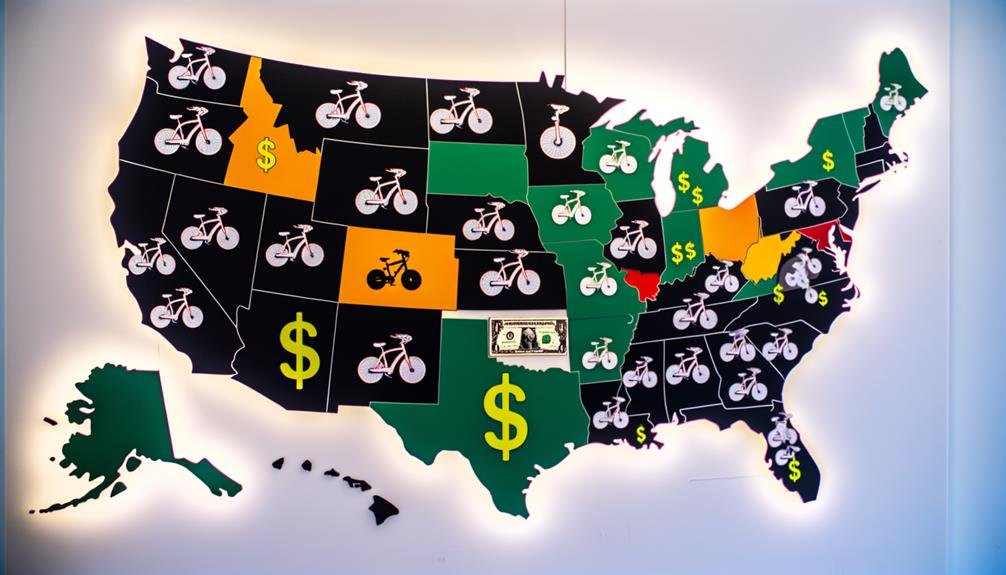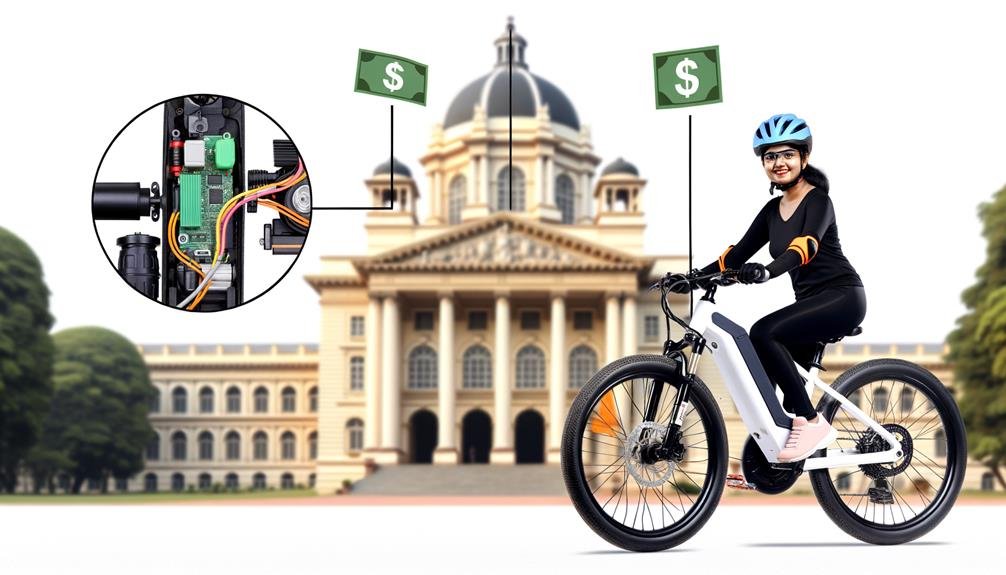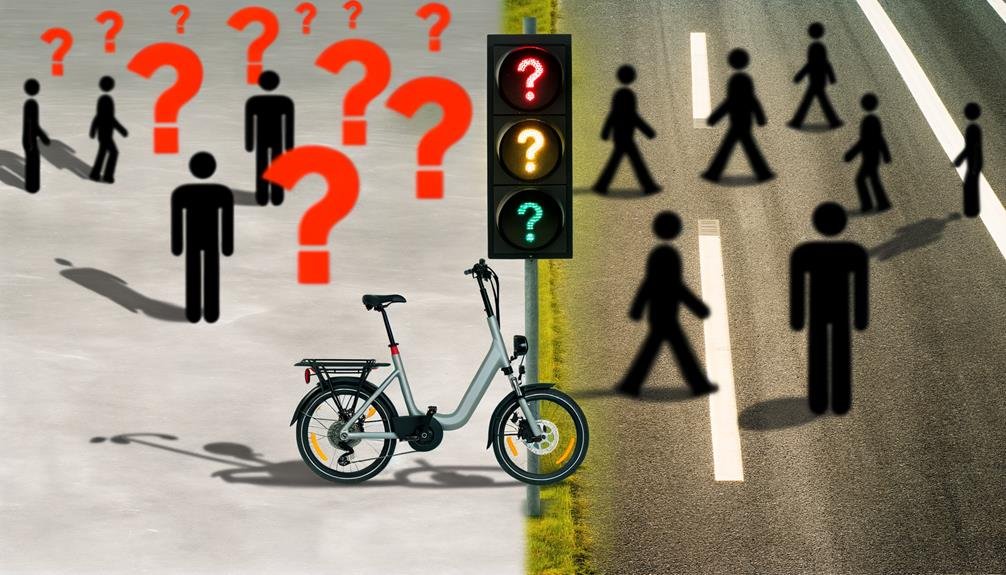Charles Miller is a veteran bike enthusiast with over 12 years of experience dealing with bikes as a mechanic. Despite immense love and expertise for...
In the world where skyrocketing fuel prices collide with the growing need for eco-friendly transportation, we've found ourselves in the midst of an electric bike revolution.
As we explore the maze of government incentives and rebates, let's start by understanding how to get a subsidy for an electric bike. It's not as daunting as it seems, but it's crucial to know the right path.
So, shall we embark on this journey together, uncovering the secrets of making e-bikes more affordable while also doing our part for the environment? The answer might be more intriguing than you think.
Key Takeaways
- Electric bike subsidies are available at both the federal and state level, providing significant incentives for purchasing electric bikes.
- The E-BIKE Act offers a tax credit of up to 30% off the cost of an electric bike, making them more affordable for individuals.
- State rebate programs, such as California's CVRP and upcoming programs in Colorado, provide additional financial incentives for electric bike purchases.
- It is important to research and understand the specific requirements and documentation needed to apply for these subsidies, as well as to keep all receipts and documentation for the application process.
Understanding Electric Bike Subsidies
To fully grasp the concept of electric bike subsidies, it's crucial to delve into various programs like federal tax credits, state rebates, and local incentives that markedly reduce the initial cost of e-bikes, making them accessible to a broader public.
For instance, the E-BIKE Act, a US government initiative, provides a tax credit of up to 30% off the e-bike cost, with a cap at $1500 for e-bikes under $8000. This incentive kickstarts the purchase of an electric bike, particularly for individuals at lower economic levels, as they can also capitalize on its refundable tax benefits.
State rebate programs, like California's Clean Vehicle Rebate Project (CVRP) and Colorado's impending e-bike rebate program, offer significant incentives for e-bike purchases. These rebates range from $1000 to $7500, further sweetening the deal for prospective e-bike owners.
Aside from affordability, these programs underscore the environmental benefits of e-bikes, such as reducing air pollution. Meanwhile, states like Florida, Illinois, and Massachusetts provide detailed information on how to apply for these rebates, ensuring we're well-informed about the electric bicycle rebate process.
Federal Incentives for E-Bikes
Let's delve into the variety of federal incentives available for e-bike purchases, starting with the E-BIKE Act, which provides a significant tax credit for individuals investing in electric bikes for commuting. This act is a major Kickstart for the Environment. It offers a refundable tax credit of up to 30% on the cost of the electric bike, with a ceiling of $1500 for bikes priced under $8000.
Furthermore, several different states offer specific incentive programs. Here's a brief comparative overview:
| State | Rebate |
|---|---|
| California | $1000 to $7500 |
| Colorado | $1100 |
| Connecticut | $500 minimum |
| Florida | 30% up to $1500 |
These programs make electric bike purchases more attainable, especially for those in lower income brackets. For example, Colorado's program specifically targets residents earning at or below 80% of the region's median income.
Tax Credits are not only an incentive but a recognition of the environmental significance of e-bikes. They're a token of belonging, of being part of the solution. In essence, the government is making it easier for us all to contribute to a greener future.
State-Specific Electric Bike Rebates

Diving into the specifics, California's Clean Vehicle Rebate Project (CVRP) leads the way in state-specific incentives for e-bikes, offering rebates from $1000 to $7500 for eligible purchases or leases. This incentive program is an essential part of supporting residential customers who choose to invest in electric bicycles.
Coming up is Colorado's rebate program, slated for launch in August 2023. They've set aside a $1100 rebate for residents earning at or below 80% of the region's median income. Similarly, Connecticut's e-bike incentive program provides a minimum of $500 rebate for their residents aged 18 and older.
Florida's Federal Electric Bike Incentive Credit Bill 2023 is particularly noteworthy. It provides a 30% tax credit of up to $1500 for e-bike purchases under $8000, specifically for Florida residents.
Oregon, Illinois, Maine, Indiana, and Vermont also contribute to this movement with their e-bike subsidy policies, offering rebates ranging from $200 to $750 for eligible residents. This is all part of the broader Environment (E-BIKE) Act.
While New York State currently lacks a specific e-bike rebate program, we hope to see them join these pioneering states soon.
Applying for E-Bike Subsidies
Having explored the various state-specific subsidies available, we'll now guide you through the process of applying for these e-bike incentives. Once you've identified the programs for which you're eligible, it's time to apply for this consumer tax credit.
These programs offer substantial savings on the purchase of electric bikes. Here are some steps to follow:
- Research and understand the specifics of the program offers. Be aware of any income restrictions or other eligibility requirements.
- Purchase your e-bike from a reputable dealer and keep all receipts and documentation relating to your purchase.
- Submit your application, including all necessary documentation, to the relevant authority.
- Wait for your application to be processed.
Through these steps, customers can receive a tax credit or rebate, significantly reducing the cost of their e-bike.
Applying for e-bike subsidies can seem complex, but with careful research and diligent application, it's a process that can ultimately be very rewarding.
Through leveraging these incentives, we're not just saving money – we're also contributing to a greener, more sustainable future.
Maximizing Subsidy Benefits

To fully leverage the available e-bike subsidies, it's crucial we look beyond the application process and focus on strategies to maximize these benefits.
An e-bike that costs less might seem tempting, but don't let sticker price alone guide your decision. Be sure to check for federal tax credits like the E-BIKE Act Consumer Tax Credit, offering a significant 30% off, making it easier to afford that dream e-bike.
Next, delve into state rebate programs. Some states, like California, offer rebates for purchasing or leasing an electric bike, further maximizing subsidy benefits. It's also important to stay informed about local incentives. For example, Colorado's upcoming e-bike rebates program is set to offer different amounts based on economic levels.
Consideration for low-income residents is a key element in many of these programs. Connecticut's e-bike program, for instance, offers a minimum rebate of $500 for income-qualified residents. Utilizing resources such as Florida Rebate Information or Illinois E-Bike Rebate can provide comprehensive knowledge and assistance in securing the subsidy for electric bike that you're eligible for.
Future Trends in E-Bike Funding
Looking beyond the current state of e-bike subsidies, we can anticipate several emerging trends in funding and policy that will shape the future of sustainable transportation.
- *Increasing Federal Involvement*: The E-BIKE Act signals a growing federal interest in promoting Electric Vehicles (EVs) and specifically e-bikes. This trend is likely to continue with additional legislation and incentives in the pipeline, aiming to make EVs accessible to all residents, not just the top 47% income bracket.
- *State-Level Incentives*: State governments are recognizing the importance of e-bike funding and are implementing rebate programs to encourage e-bike adoption among residents.
- *Local Subsidies*: Local governments are increasingly offering subsidies for e-bikes. This trend is especially crucial in densely populated urban areas where sustainable transportation options like bicycles are more viable.
- *Future Trends in Subsidy Policies*: As e-bikes become more popular, we can expect future trends to include more expansive and inclusive subsidy policies.
These anticipated future trends in e-bike funding highlight the growing recognition of e-bikes as a key player in the push towards sustainable transportation.
Frequently Asked Questions
Is There a Tax Credit for Buying an Electric Bike?
Yes, there's a tax credit for buying an electric bike. We're eligible for federal incentives and local programs based on qualifying purchases. The application process involves credit calculation, considering legislative updates for electric bike financing.
What Is the Ebike Rebate in the Us?
We're seeing a rise in e-bike rebates across the US. Eligibility varies by state, but typically includes application processes, qualifying e-bikes, and specific rebate amounts. It's a positive step towards sustainable transport.
What Is the Ohio Ebike Program?
We're discussing the Ohio Ebike Program, focusing on program eligibility, funding sources, the application process, program limitations, qualifying bikes, program duration, its impact, and related Ohio legislation. It's about promoting eco-friendly transportation in Ohio.
How Can I Afford an Electric Bike?
We're exploring options like electric bike financing, loans, crowdfunding, buying second hand, bike sharing, discounts, employer programs, and manufacturer incentives. We aim to make e-bikes affordable without depending on subsidies.
Conclusion
In a nutshell, we've navigated the sea of electric bike subsidies, from federal incentives to state-specific rebates.
We've learned how to apply and maximize these benefits, casting a light on the path to affordable, eco-friendly transport.
So, let's ride the wave of sustainability, folks. We foresee a bright future in e-bike funding, making it easier for us all to pedal towards a greener tomorrow.

Charles Miller is a veteran bike enthusiast with over 12 years of experience dealing with bikes as a mechanic. Despite immense love and expertise for his Tacoma, he rides his Trek Ebike more. Anytime you meet him, you’ll either hear him talking about Bikes, or writing about all things bikes and cars on this blog.
More Posts


